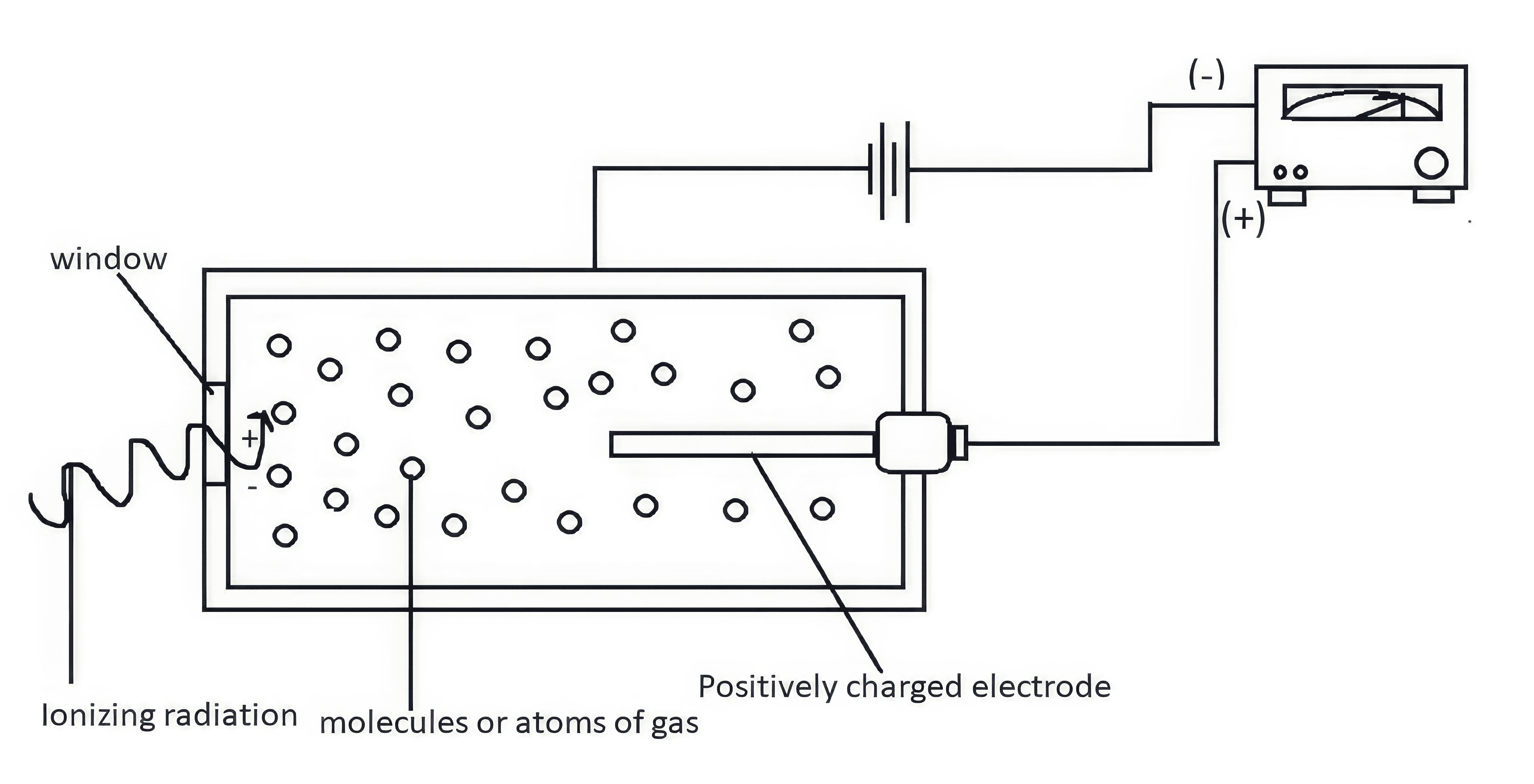A Geiger-Muller counter, commonly referred to as a GM counter or simply Geiger counter, is a widely-used device for detecting and measuring ionizing radiation, such as alpha particles, beta particles, and gamma rays. Invented by Hans Geiger and Walther Müller in the 1920s, the GM counter has since become a staple instrument in various fields, including nuclear physics, radiological protection, and environmental monitoring.
Construction
The main components of a GM counter include:
- Hollow metallic chamber (Cathode): The GM counter consists of a hollow cylindrical metallic chamber, usually made of materials such as stainless steel, brass, or aluminum. The chamber acts as the cathode and is responsible for containing the gas and providing an electrically conductive surface.
- Thin wire anode: A thin wire, made of materials like tungsten or platinum, is placed along the axis of the metallic chamber, serving as the anode. This wire is connected to a high-voltage power supply and is responsible for attracting the ionized electrons created within the chamber.
- Sealed window: The chamber features a sealed window, often made of materials like mica or thin metal foil, that allows radiation to enter the chamber. The window must be thin enough to allow particles or photons to pass through while maintaining the integrity of the gas-filled chamber.
- Inert gas: The chamber is filled with an inert gas, such as helium, neon, or argon, at low pressure (typically around 100 torr). This gas plays a crucial role in the ionization process and the subsequent detection of radiation.
- Counter: The anode wire is connected to an electronic counting system or a pulse-counting device, which measures the number of ionization events occurring within the chamber. This information can then be used to calculate the radiation intensity or dose rate.
Working
The operation of a Geiger-Muller counter can be divided into several stages:
- Ionization: When ionizing radiation enters the chamber through the sealed window, it interacts with the inert gas atoms, causing the gas to become ionized. This ionization process results in the formation of positively charged ions and free electrons.
- Acceleration and avalanche: The high voltage applied to the anode wire creates an electric field within the chamber. The free electrons produced during ionization are accelerated towards the anode by the electric field. As these electrons gain energy, they collide with other gas atoms, causing further ionization and the creation of more free electrons. This chain reaction, known as a Townsend avalanche, amplifies the initial ionization event, producing a large number of electrons and ions.
- Pulse generation and detection: The electrons generated during the avalanche are attracted to the anode wire, creating a brief electric pulse. The positively charged ions, on the other hand, are attracted to the cathode, where they are neutralized. The electric pulse generated by the avalanche is detected and counted by the electronic counting system connected to the anode wire.
- Dead time and recovery: After an ionization event, the GM counter experiences a period of insensitivity, known as the dead time, during which it is unable to detect additional radiation. This is because the ions and electrons need time to recombine or neutralize before the electric field within the chamber can be restored. Once the chamber has recovered, the GM counter is ready to detect further ionizing radiation.
Limitations
Despite its widespread use, the Geiger-Muller counter has a few notable limitations:
- Lack of discrimination: A GM counter is unable to differentiate between different types of ionizing radiation, such as alpha particles, beta particles, and gamma rays. This is because the counter detects the ionization events within the chamber rather than the specific properties of the incident radiation. As a result, GM counters are generally used for measuring radiation intensity rather than identifying specific radiation types.
- Dead time: As mentioned earlier, after each ionization event, the GM counter experiences a period of insensitivity called the dead time. During this period, the counter is unable to detect or measure additional radiation. For low radiation levels, this is usually not an issue. However, at high radiation rates, the dead time can result in an underestimation of the actual radiation intensity, as the counter may miss some ionization events.
- Limited energy resolution: GM counters do not provide accurate information about the energy of the detected radiation. The counting system records each ionization event as a single count, regardless of the energy deposited by the radiation. This limits the usefulness of GM counters in applications where energy information is important, such as gamma-ray spectroscopy.
- Quenching requirement: In order to prevent continuous discharges and maintain stable operation, GM counters require the addition of a quenching agent to the inert gas. The quenching agent, usually a small amount of organic vapor or a halogen gas, helps to rapidly neutralize the ions and electrons within the chamber, reducing the likelihood of continuous discharges. The presence of a quenching agent adds complexity to the design and operation of the GM counter.
Applications
Despite these limitations, Geiger-Muller counters are widely used in a variety of applications, including:
- Radiological protection: GM counters are commonly used to monitor radiation levels in the environment, workplaces, and other areas where ionizing radiation may pose a risk to human health. They can be used to detect radiation leaks, measure dose rates, and ensure compliance with safety regulations.
- Nuclear physics research: In nuclear physics experiments, GM counters can be used to detect the presence of radioactive materials or measure the intensity of ionizing radiation produced during experiments.
- Environmental monitoring: Geiger-Muller counters can be employed to monitor background radiation levels in the environment and detect changes in radiation levels that may be indicative of radioactive contamination.
- Education and outreach: GM counters are often used in educational settings and public outreach programs to demonstrate the presence and detection of ionizing radiation, helping to raise awareness about radiation and its potential hazards.
